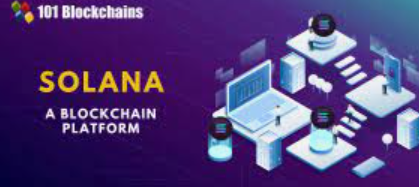In the ever-evolving world of cryptocurrencies, Solana has emerged as a popular blockchain platform for conducting fast and secure transactions. With its innovative features and robust infrastructure, Solana offers several benefits for individuals and businesses seeking efficient transactional solutions. However, like any other technology, it is important to weigh the advantages against the potential drawbacks before fully embracing it. In this article, we will explore the benefits of using Solana for transactions, shedding light on its potential impact on the digital economy as we bring it together with trading portals such as Profit Edge.
Understanding Solana
Before delving into the benefits and drawbacks, let’s first gain a better understanding of Solana. Founded by Anatoly Yakovenko in 2017, Solana is an open-source blockchain platform designed to provide fast and scalable solutions for decentralized applications (dApps) and cryptocurrencies. It utilizes a unique combination of Proof of History (PoH) and Proof of Stake (PoS) consensus mechanisms to achieve high transaction throughput and low fees.
The Benefits of Using Solana for Transactions
- High Scalability and Throughput
One of the key advantages of Solana is its ability to handle a significantly high number of transactions per second. With its innovative consensus mechanism, Solana has achieved impressive scalability, capable of processing thousands of transactions within seconds. This makes it an ideal choice for applications that require fast and efficient transaction processing, such as decentralized exchanges, gaming platforms, and financial applications.
- Low Transaction Fees
In addition to scalability, Solana offers low transaction fees compared to other blockchain platforms. The use of Proof of Stake reduces the need for extensive computational resources, resulting in reduced energy consumption and transaction costs. This affordability makes Solana an attractive option for businesses and individuals looking to conduct frequent transactions without incurring hefty fees.
- Robust Security
Solana’s security is reinforced by its unique combination of Proof of History and Proof of Stake mechanisms. Proof of History provides a verifiable and tamper-proof record of events, enhancing the overall security and integrity of the blockchain. Furthermore, Solana’s decentralized nature and consensus algorithm make it highly resilient against attacks, ensuring the safety of transactions and user data.
- Developer-Friendly Environment
Solana provides developers with a comprehensive set of tools and resources to build decentralized applications. Its ecosystem offers a wide range of programming languages, smart contract support, and developer-friendly frameworks, enabling rapid application development. Developers can leverage Solana’s efficient infrastructure and extensive documentation to create innovative solutions that can scale seamlessly.
- Interoperability
Another notable benefit of using Solana is its interoperability with other blockchain networks. Solana’s architecture allows for seamless communication and integration with various protocols and smart contract platforms. This interoperability expands the possibilities for cross-chain transactions, asset transfers, and collaboration between different blockchain ecosystems, fostering a more connected and inclusive digital economy.
The Drawbacks of Using Solana for Transactions
While Solana offers numerous advantages, it is essential to consider its potential drawbacks before fully embracing it for transactional purposes. Here are a few noteworthy points to keep in mind:
Relatively New Platform
Compared to more established blockchain platforms like Ethereum, Solana is relatively new. As with any emerging technology, there is a certain degree of uncertainty surrounding its long-term viability and widespread adoption. While Solana has shown promising growth and gained popularity, it is crucial to closely monitor its development and community support.
Limited Ecosystem
Although Solana’s ecosystem is rapidly expanding, it is still relatively smaller compared to more established platforms. This could pose challenges for developers seeking a wide range of available tools and resources. While Solana does offer a growing set of developer-friendly features, it may not have the same extensive library of smart contracts, decentralized applications, and community support as larger blockchain ecosystems. Developers may need to invest additional time and effort to build and integrate their applications within the Solana ecosystem.
Centralization Concerns
Solana’s consensus mechanism relies on a network of validators that secure the blockchain. However, some critics argue that the current validator distribution leans toward centralization, as a limited number of entities control a significant portion of the network’s voting power. This concentration of power may raise concerns about decentralization and censorship resistance, which are core principles of blockchain technology.
Potential Scalability Challenges
While Solana boasts impressive scalability, it is worth considering the potential challenges that may arise as the network continues to grow. Scaling a blockchain platform requires careful management of network resources and infrastructure. It remains to be seen how Solana will handle the increasing demands of a larger user base and the scalability requirements of complex decentralized applications.
Regulatory Uncertainty
As with any blockchain platform, Solana operates within a legal and regulatory landscape that is still evolving. Governments and regulatory bodies around the world are grappling with how to classify and regulate cryptocurrencies and blockchain technologies. The evolving nature of regulations may introduce uncertainties and compliance challenges for businesses and individuals operating within the Solana ecosystem.
Conclusion
Solana presents a compelling solution for fast, scalable, and secure transactions in the digital economy. Its high throughput, low fees, robust security, and developer-friendly environment make it an attractive choice for various applications. However, it is crucial to consider the potential drawbacks, such as its relative newness, limited ecosystem, centralization concerns, scalability challenges, and regulatory uncertainties.
Read article more anmolideas



